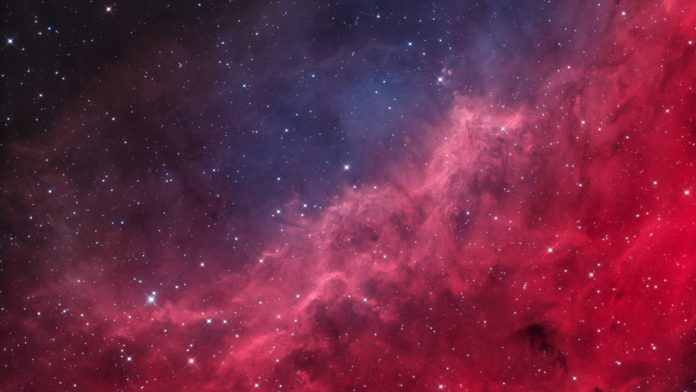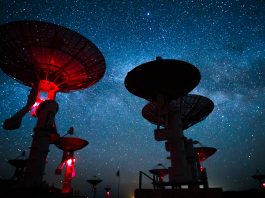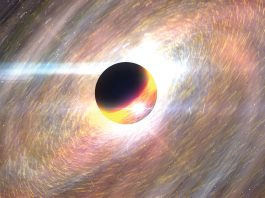Yale University’s Professor Karsten Heeger and Temple University’s Professor Jim Napolitano outline the study of neutrino oscillations with Daya Bay and PROSPECT: a collaboration across four continents to probe the ‘ghost particle’ of the Universe.
Neutrinos are fascinating elementary particles which may hold the key to understanding the most fundamental properties of the Universe. Although first postulated some 90 years ago, and not discovered until 25 years later, we have learned of their innate complexity only in the past two decades. This has been achieved through a series of experiments in Canada, Japan, China, Europe, and the United States. Mysteries remain, but we are on the cusp of new discoveries that will lead to a profound understanding of the laws that describe our physical world, including the origin of primordial matter.
From postulation to discovery
When Wolfgang Pauli first postulated the existence of neutrinos in 1930, it seemed almost impossible to detect them. Neutrinos, also known as the Universe’s ‘ghost particle’, are weakly interacting and can pass mostly unaffected through large distances of ordinary matter. Only rarely do they interact and produce a signature that can be detected.
Shortly after Pauli’s postulate of an invisible particle, it was suggested that the large flux of neutrinos from nuclear reactions could be used to observe and study these particles. A series of experiments by Frederick Reines, Clyde Cowan and collaborators at the Savannah River reactor in the US eventually led to the first observation of the free antineutrino. Since then, a number of experiments at reactor facilities around the world including Switzerland, France, Japan, Russia, and China have studied the properties of neutrinos and dramatically changed our view of the role of this elusive particle in the Universe.
At the time of Pauli, it was known that neutrinos must have a much lower mass than any other known subatomic particle. They were tacitly assumed, therefore, to have zero mass. It is not difficult to explain why a fundamental elementary particle would have a mass of exactly zero, so this found its way into textbooks as fact. Indeed, searches for a finite neutrino mass have been carried out for many decades, with no confirmed positive direct evidence to date.
However, 20 years ago, three very different experiments discovered that the three distinct neutrino species, called ‘flavors’, can transform into each other through a quantum mechanical process called ‘neutrino oscillations’. Experiments studying neutrinos from the Sun (SNO), using neutrinos from accelerators (K2K), and reactor neutrinos (KamLAND) have demonstrated that neutrinos change flavor and provided evidence for the phenomenon of neutrino oscillation.
It is now understood that the three (known) ‘flavors’ of neutrinos consist of three mass eigenstates and undergo quantum mechanical mixing with each other. The mixing parameters are intimately tied to the neutrino mass, and oscillations occur because a phase difference appears between the different mass components as neutrinos propagate. That is, the discovery of neutrino oscillations tells us that the difference in neutrino masses is nonzero, and that at least two of the neutrino states have mass. This discovery led to the 2015 Nobel Prize in Physics.
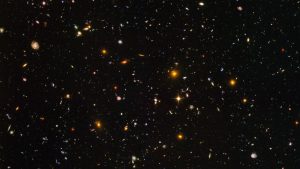
Neutrinos and the Universe
For reasons we do not yet understand, the fundamental particles that make up matter organise themselves into two families and three generations. The families, quarks and leptons, are distinguished by the ways they interact amongst themselves. Although all these particles can participate in the electroweak interaction, only the quarks interact through the so-called ‘strong force’. The interactions are all very well defined in the context of theoretical physics, and the predictions of these theories have been tested against experiment in every conceivable way. No disagreement between theory and experiment has ever survived careful scrutiny.
The quarks and leptons each separate into pairs that label their characteristics with respect to the electroweak interaction. Each pair of quarks or leptons constitute a generation. That is, there are a total of six known quarks and six known leptons. The lepton pairs each consist of a charged particle and an associated uncharged neutrino. The charged particles are the electron (e), muon (μ), and tau (τ), and their neutrino partners are called νe, νμ, and ντ .
For each of these fundamental particles there is a corresponding antiparticle which has the opposite charge (and other signed properties). The neutrinos are electrically neutral but have other properties which change sign between particle and antiparticle, and this leads to a unique and very interesting situation. That is, the neutrino and antineutrino could be distinct particles, so-called ‘Dirac neutrinos’, or they could exist in Nature with equal components of particle and antiparticle, so-called ‘Majorana neutrinos.’ In the latter case, we say, colloquially, that the neutrino is its own antiparticle.
These facts all tie together and lead to a fascinating scenario with implications for how we understand the Universe. The figure above is an image from the Hubble Space Telescope in 2004, a very long exposure on a particularly starless patch of sky (Fig. 1).
Nearly every object in the image is a distant galaxy (stars appear as objects with ‘points’), and every one of those galaxies consists of matter, not antimatter. If matter and antimatter are symmetric forms of matter, then how is it that only matter remains today, 13 billion years after the Big Bang?
It is widely believed that neutrinos carry the answer to this question. The first clue is their tiny, but nonzero, mass. We know that all the interactions merge into a single form when particles collide at an energy near 1016 GeV, the so-called ‘Grand Unified mass’. We also know that the scale of the electroweak interaction, which defines the neutrino flavors, is 102 GeV. One scenario of a unified picture of the fundamental particles starts with two kinds of neutrinos, one with zero mass and one with a Grand Unified mass. It is simple to show that ‘turning on’ the electroweak interactions naturally leads to a neutrino mass near 10-3 eV, perfectly within the expected range implied by mass differences from neutrino oscillation experiments.
This is called the ‘Seesaw Mechanism’”, named after the children’s playground contraption in which one side goes up when the other is pushed down. In order for the Seesaw Mechanism to be realised mathematically, however, neutrinos need to be Majorana particles. The resulting theory also suggests the existence of lighter, purely right-handed ‘sterile’ neutrinos, which cannot react through the electroweak interaction, so cannot be directly detected.
If this scenario is correct, then the massive neutrino counterpart would play an important role in the early Universe, when temperatures and energy densities were extraordinarily high. If neutrinos do not respect a particle-antiparticle symmetry, something known as ‘CP Violation’, then it is not difficult to construct a mathematically consistent physical model that would explain why the Universe is filled with matter and not antimatter.
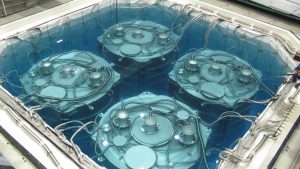
© Qiang Xiao
Precision studies of neutrino oscillations with Daya Bay
The results from SNO, K2K, and KamLAND showed that neutrinos indeed must have nonzero masses, and that there was quantum mechanical mixing between the second and third generations (K2K) and the first and second generations of the neutrinos mass eigenstates (KamLAND). The observation of neutrino flavor change goes a long way towards satisfying conditions for explaining the matter-antimatter asymmetry in the Universe.
However, there was a missing link. For CP Violation to be possible in the neutrino sector, there must also be mixing between the first and third generations. In the vernacular of particle physics, the mixing angle θ13 cannot be zero. All results from existing experiments prior to Daya Bay, however, suggested that θ13 was consistent with zero and in fact much smaller than the values of θ23 and θ12, as measured by K2K and KamLAND, respectively.
The Daya Bay Reactor Neutrino Experiment is an international collaboration based on the long-standing partnership between China and the US in high energy physics. The project leverages access to a unique experimental facility at a nuclear reactor complex and decades of experience in neutrino experiments. Its primary goal was to carry out an extremely sensitive search for nonzero θ13 by making precision measurement of neutrino oscillations. As with the original Reines and Cowan experiment, nuclear reactors were used as the terrestrial neutrino source, but thanks to K2K and KamLAND, this time we knew where to look. K2K gave a value for the mass difference between the second and third neutrino generations, and KamLAND gave a much smaller number for the mass difference between the first and second. That meant that the mass difference between the first and third must be nearly the same as the value determined by K2K. This suggested that the optimum distance to search for oscillations between generations one and three is between 1-2km for MeV neutrinos emitted from nuclear reactions
Neutrino oscillations cause the electron flavor to ‘disappear’ over some distance, and then come back some distance later, because of quantum mechanical interference with the other flavors. The probability that neutrino flavor νa, produced at one location, will be detected as νa at a location a distance (L) away, is P(νa→νa) = 1-sin2(2θ13)sin2(1.27 Δm2 L/E) where L is expressed in metres, and the neutrino energy is E in MeV. Given the value of Δm2 from K2K, and knowing the average energy of neutrinos from a nuclear reactor, the Daya Bay collaboration knew to locate their detectors about 2km from the reactor core.
Six nuclear reactors, arranged pairwise in three separate locations, make up the Daya Bay and Ling Ao nuclear power plant facilities in Southeastern China, not far from Hong Kong. The six reactors are essentially identical, and all located within 1km of each other. Situated on the Pacific Ocean, a steep rock formation rises quickly as one moves away from the coast. The neutrino detectors are located in caverns underneath these hills, which provide an excellent barrier against cosmic rays which typically plague neutrino experiments.
Reactors produce electron-type antineutrinos (νe) from the radioactive decay of fission fragments in the reactor core. Although they are a copious source of neutrinos, it is notoriously difficult to accurately calculate the neutrino flux from a nuclear reactor. The goal of the Daya Bay experiment was a 1% sensitivity. That is, if sin2(2θ13) was as small as 0.01, the collaboration wanted to observe it. However, it is impossible to predict the reactor neutrino flux this accurately and a relative measurement of the change of neutrino flavor as a function of distance from the reactors was needed.
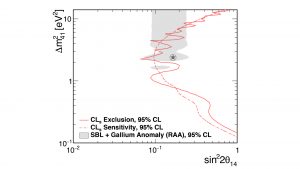
© 2017 American Physical Society
They Daya Bay experiment solved this problem by building eight identical 20-tonne neutrino detectors allowing a simultaneous measurement of the reactor antineutrino flux at near and far distances. Two of the detectors were about 300m from the Daya Bay power plant, two more were as close to the Ling Ao power plant, and four detectors were placed at the optimum distance of 2km. The ‘near’ detectors were essentially monitoring the power plant neutrino output, and the ‘far’ detectors would be sensitive to neutrino oscillations. More precisely, the combination of ‘near’ and ‘far’ detectors let the collaboration search for deviations from a 1/r2 dependence on the neutrino flux, where r is the nominal distance from the reactor core.
Fig. 2 shows a photograph of the four ‘far’ detectors, in place in the underground cavern 2km from the reactors. The antineutrino detectors are 5m in diameter and 5m high cylinders and utilise a detection principle very similar to the original Savannah River experiment. They are submerged in a 16m×16m×10m deep pool filled with high purity water, which protects the detectors from ambient radioactivity and to detect cosmic ray muons, both of which could mimic the neutrino signal.
Fig. 3 shows the oscillation probability P(νe→νe) and shows a maximum disappearance probability of nearly 10%. This is several times larger than the design sensitivity of the experiment! This result opened the field to extract a signal for CP violation in ongoing and forthcoming neutrino beam experiments such as T2K and T2HK in Japan as well as NOVA and DUNE in the US. The ‘standard’ neutrino mixing scenario is looking attractive for explaining the matter asymmetry of the Universe.
PROSPECT: searching for the ‘sterile’ neutrino
The precision achieved by Daya Bay was unprecedented for neutrino experiments. This, of course, made it possible to determine a precise value for θ13, but it also let scientists look very carefully at the details of the neutrino production at nuclear reactors. This in turn led to some surprises, including indications of the existence of the ‘sterile’ neutrino that might result from the Seesaw Mechanism.
Daya Bay was designed with near and far detectors in order to avoid having to know the absolute reactor flux. Nevertheless, the detectors were calibrated carefully enough to allow a precise measurement of the neutrino production rate from the reactor cores. Both the near and far detectors agree (after correcting for neutrino oscillations) that the measured neutrino intensity is about 6% smaller than predicted. This so-called ‘Reactor Antineutrino Anomaly’ (RAA) is consistent with results from other experiments at other reactors, and its source remains a mystery to this day.
To be sure, it is very difficult to calculate the neutrino flux from a reactor, in particular the nuclear power plant reactors that make up the bulk of neutrino sources modern measurements. Energy is derived from nuclear fission, and the radioactive fission daughter nuclei undergo beta decay, releasing neutrinos. The distribution of daughter nuclei, however, is broad and not particularly well known, and their beta decay properties are also considerably uncertain. Furthermore, at a power plant reactor, the fission fuel is a combination of 235U and 239Pu which changes over time as the reactor operates. Nevertheless, heroic efforts by a number of scientists have led to confidence in the community that the reactor flux itself is known with 1-2% precision. This means that the 6% effect that is the RAA must have some other origin.
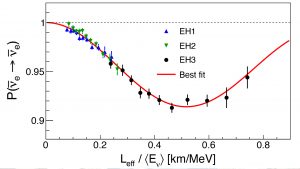
A fourth neutrino with a mass near 1 eV/c2 could explain the RAA if it mixes with the much lighter electron neutrino. For such values of Δm2 the oscillation would be on the order of one metre, smaller than the dimensions of a power plant reactor core or detectors similar to Daya Bay. Therefore, the oscillations would be washed out in existing experiments, leading simply to a reduction in flux by sin2(2θ14)/2. This fourth neutrino could be sterile, that is, have no interaction with matter, and would manifest itself only by virtue of neutrino disappearance.
The Precision Oscillation and Spectrum (PROSPECT) experiment was conceived to search for metre scale oscillations from a compact nuclear reactor core, namely the High Flux Isotope Reactor (HFIR) at Oak Ridge National Laboratory in the United States. Fig. 4 shows a diagram of the detector installed at HFIR. The reactor core is compact, only 44cm in diameter and 51cm high, providing, essentially, a point source for neutrinos with oscillation lengths on the order of metres. The detector is a 2m×2m×2m cube, located about 7m from the core, and is built from 154 optically isolated 15cm×15cm×2m modules oriented perpendicular to the direction to the neutrino source.
Neutrinos are once again detected using the same principle used by Cowan and Reines, and the interaction can be localised to a particular module. By comparing the rates across the modules, and accounting for the 1/r2 fall off, the experiment searches for meter scale oscillations within the detector volume. Fig. 5 shows the latest results from an oscillation search with PROSPECT. The region of Δm2 versus sin2(2θ14) space to the left of the red solid line is excluded at 95% confidence level by the measurement. The gray shaded area shows the region consistent with various measurements that might indicate sterile neutrino oscillations, and one point is marked as the ‘best fit’ RAA result. This best fit result appears to be excluded by PROSPECT, as is most of the gray area.
However, this does not mean that sterile neutrinos do not exist. It only means that sterile neutrinos are highly unlikely in the minimal implementation consistent with the RAA. Many other experiments are planned that will search elsewhere for sterile neutrino phenomena.

Summary and outlook
The past two decades have seen an enormous increase in our knowledge base about neutrinos, first postulated 90 years ago and first observed 65 years ago. We now know that at least two neutrino species have mass, and that all three neutrino species have different masses. We have reasonable scenarios in which the neutrino is responsible for the existence of ordinary matter in the Universe. We also have new mysteries, including the specific interactions that give rise to the Universe as we know it, and discrepancies with the standard picture of three neutrino flavors.
Experiments are ongoing and planned to try and solve these mysteries. Among them are the STEREO experiment at the nuclear reactor facility at the IInstitut Laue–Langevin (ILL) in France, and an upgrade to PROSPECT that is underway. The future is exciting to contemplate.
Summary and outlook
The authors thank their collaborators in the Daya Bay Reactor Neutrino Experiment and the Precision Oscillation and Spectrum Experiment for productive and enjoyable interactions. This work was supported in part by grants from the US Department of Energy Office of High Energy Physics.
References
- Ernest Ma (UC, Riverside), ‘Pathways to naturally small neutrino masses’, Phys.Rev.Lett. 81 (1998) 1171-1174
- Daya Bay Collaboration, ‘Measurement of the Electron Antineutrino Oscillation with 1958 Days of Operation at Daya Bay’, Phys.Rev.Lett. 121 (2018) 24, 241805
- PROSPECT Collaboration, ‘Improved Short-Baseline Neutrino Oscillation Search and Energy Spectrum Measurement with the PROSPECT Experiment at HFIR’, e-Print: 2006.11210 [hep-ex]; Submitted to Phys.Rev. D
Karsten Heeger
Director, Wright Laboratory
Professor of Physics and Department Chair
Yale University
+1 203 432 3378 (Heeger)
karsten.heeger@yale.edu
Tweet @YalePhysicsDept
https://wlab.yale.edu
Jim Napolitano
Professor of Physics and Department Chair
Temple University
+1 215 204 7827 (Napolitano)
tuf43817@temple.edu
Tweet @TempleUniv
https://www.temple.edu
Please note, this article will also appear in the third edition of our new quarterly publication.

